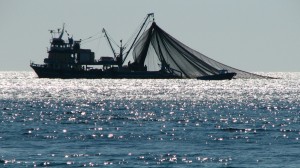- Tahoe’s Nevada Beach Tops the List of Hard-to-Book Campgrounds - 07/17/2024
- Cannabis Watershed Protection Program Cleans Up Illegal Grow Sites - 07/10/2024
- French Fire - 07/05/2024

The next frontier in sprawl may be on the high seas, where the proliferation of fishing, shipping, tourism, resource extraction, energy development, military exercises and other human activity has begun to call into question just how vast our oceans really are. Pictured: a fishing trawler on the high seas. Photo: Jon Anderson/Flickr
I recently heard the term “ocean sprawl,” which was a new one on me. We all know “sprawl” as it manifests itself above sea level. But in the oceans? Can you enlighten?
— Bill Chadwick, Nantucket, MA
We are all familiar by now with “urban sprawl”—the uncontrolled spread of urban development into areas beyond the city. But environmentalists warn that the next frontier in sprawl is on the high seas, where the proliferation of fishing, shipping, tourism, resource extraction, energy development, military exercises and other human activity has begun to call into question just how vast our oceans really are.
According to the non-profit Natural Resources Defense Council (NRDC), our oceans are already under siege from problems like pollution, overfishing and acidification, and increased industrial activity off-shore—leading to so-called “ocean sprawl”—will jeopardize the food, jobs and recreation we have come to depend on the oceans to provide. It’s hard to believe, given how much planning goes into various types of development and human activity on land, that the oceans are still like the Wild West—with various entities staking claims on huge stretches of open water for different purposes.
A promising approach to combat ocean sprawl is called coastal and marine spatial planning (CMSP), a form of zoning for the seas to help define who can do what and where. Says the National Oceanic and Atmospheric Administration (NOAA), the federal agency charged with predicting changes in climate, weather, oceans and coasts, CMSP “identifies areas most suitable for various types or classes of activities in order to reduce conflicts among uses, reduce environmental impacts, facilitate compatible uses and preserve critical ecosystem services to meet economic, environmental, security and social objectives.”
“Marine planning places sound science and the best available information at the heart of decision-making and brings federal, state, tribal and other partners together to cooperatively develop coastal and marine spatial plans,” continues NOAA. “This process is designed to decrease user conflict, improve planning and regulatory efficiencies, decrease associated costs and delays, engage affected communities and stakeholders, and preserve critical ecosystem functions and services.”
President Obama’s 2010 National Ocean Policy directs NOAA and other federal agencies to work with ocean users, industries and coastal communities on ways to implement CMSP in America’s off-shore waters to prevent ocean sprawl at home while setting an example for other nations around the world. Nine regional planning bodies are currently tasked with developing detailed plans for their own regions by early 2015, at which point federal policy makers will begin to coordinate implementation.
In response to momentum on CMSP, a coalition of industries including offshore energy, shipping, fisheries, recreation, mining and others formed the World Ocean Council to have a say in how and where marine spatial planning is implemented. The group organized a National Business Forum on Marine Spatial Planning in 2011 and will take part in a World Ocean Summit in San Francisco in February 2014.
Those of us who appreciate the sea certainly hope that CMSP and other approaches will succeed in turning the tide for oceans and not be undermined by special interests only concerned with bottom lines.
CONTACTS: NRDC, www.nrdc.org; NOAA Coastal & Marine Spatial Planning, www.msp.noaa.gov; World Ocean Council, www.oceancouncil.org.
EarthTalk® is written and edited by Roddy Scheer and Doug Moss and is a registered trademark of E – The Environmental Magazine (www.emagazine.com). Send questions to: earthtalk@emagazine.com.













